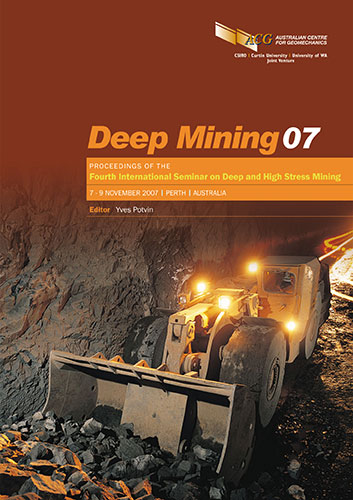Excess Shear Stress Analysis of Seimicity Associated with Dykes

|
Authors: James, JV; Rangasamy, T; Petho, SP |
DOI https://doi.org/10.36487/ACG_repo/711_1
Cite As:
James, JV, Rangasamy, T & Petho, SP 2007, 'Excess Shear Stress Analysis of Seimicity Associated with Dykes', in Y Potvin (ed.), Deep Mining 2007: Proceedings of the Fourth International Seminar on Deep and High Stress Mining, Australian Centre for Geomechanics, Perth, pp. 21-30, https://doi.org/10.36487/ACG_repo/711_1
Abstract:
The design for mining the South Deep wide reef orebody was evolved from 1990 to 1997. When the regional stability pillars were laid out it was decided that to minimise loss of ore the Gemsbokfontein no. 2 dyke was included as the core of a 50 m wide pillar encasing the 25 m wide dyke. The dyke pillar was investigated using both elastic and inelastic numerical modelling. Assessment of the size of the modelled ESS lobes during the various stages of mining, led to the conclusion that a maximum magnitude seismic event up to 2.9 could have been expected on the dyke. This was only anticipated toward the end of mining. Mining has subsequently occurred with the pillar left as designed. In July 2005 a 2.9 magnitude seismic event occurred on the dyke where it intersects another small dyke. Six seismic events with local magnitudes greater than 2 were measured in the pillar area over a 2.5 year period up to 2006. The distribution of seismic events indicates that major events were related to 2 smaller dykes intersecting the pillar. A re-evaluation of the excess shear stress (ESS) on the planes of the three dykes was undertaken to assess the potential seismic risk. The correlation between the maximum expected magnitude assessed from ESS modelling and actual magnitudes was remarkably good and also confirmed the original work completed in 1996. The use of Boundary Element codes in predicting seismicity by ESS determination is remarkably accurate considering the simplicity of the codes. On going modelling of this nature would be a useful tool for designing mining sequence and layout to ameliorate seismic activity and avoid working in seismically active mines. During a period of more than a decade the use of ESS studies with elastic modelling to anticipate the location, timing and magnitude of seismicity has been successfully demonstrated at the South Deep Mine. This research showed that the seismicity experienced could be anticipated and that mine design can be modified to avoid seismic risk.
References:
Itasca Consulting Group, Inc. (1992) FLAC2D: Fast Lagrangian Analysis of Continua. FLAC, 3.2 Users Manual. Itasca
Consulting Group, Inc.
James, J.V. (1998) Geotechnical influences upon the design and operation of a deeplevelwide orebody gold mine. PhD
thesis submitted to the University of Wales, College of Cardiff.
McGarr, A. and Weibols, G.A. (1977) Influence of mine geometry and closure volume on seismicity in a deep level
mine. International Journal of Rock Mechanics Mining Science and Geomechanics, Abstracts Vol. 14.
Mining Stress Systems (1997) Users guide for BESOL/MINAP_97 for Windows:Minining Applications for Boundary
Element Methods, Version 1.00. Mining Stress Systems (Pty) Ltd. Johannesburg
Ryder, J.A. (1988) Excess shear stress in the assessment of geologically hazardous situations. Journal of South African
Mining and Metallurgy, Vol. 88 (1), pp. 27-39.
Salamon, M.D.G. (1984) Energy considerations in rock mechanics; fundamental results. Journal of South African
Mining and Metallurgy, Vol. 78 (1), pp. 27-39.
Excess Shear Stress Analysis of Seismicity Associated With Dykes J.V. James, et al.
30 Deep Mining 07, Perth, Australia
© Copyright 2025, Australian Centre for Geomechanics (ACG), The University of Western Australia. All rights reserved.
View copyright/legal information
Please direct any queries or error reports to repository-acg@uwa.edu.au
View copyright/legal information
Please direct any queries or error reports to repository-acg@uwa.edu.au